Small Yellow Flowering Trees (With Pictures): Identification Guide

Small yellow flowering trees add a burst of color to your garden, brightening up the space with their sunny blooms. These trees are perfect for compact spaces and can add a touch of natural beauty to any landscape.
Some of the finest small, yellow-flowering trees include ornamental golden wreath wattle trees, renowned for their striking yellow blooms. Another excellent choice is the golden chain tree, featuring large, pendulous flower clusters. The golden wonder tree, boasting abundant conical clusters of small, yellow flowers, is also a stunning addition that will enhance the curb appeal of your garden.
This article serves as a guide for those interested in small yellow flowering trees. In this article you will find descriptions, images, and essential gardening information about the best small yellow flowering trees.
Small Yellow Flowering Trees (With Pictures)
Brighten up your garden landscape with these beautiful small yellow flowering trees:
Witch Hazel (Hamamelis)
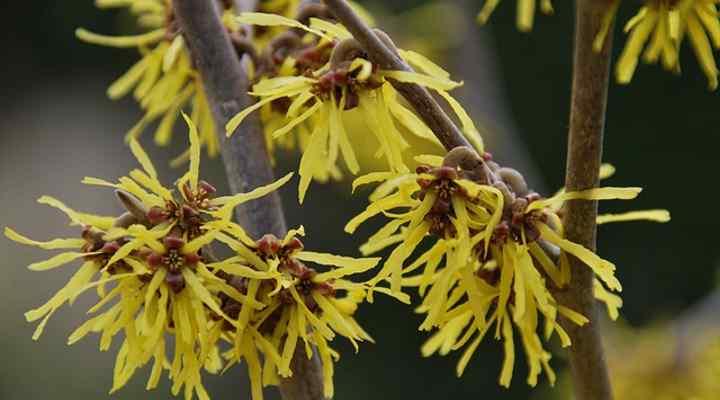
Witch Hazel (Hamamelis)
The witch hazel is a large deciduous shrub or small tree with fascinating, spider-like yellow flowers. The witch hazel tree blooms between October and February, covering its leafless, woody stems with yellow flowers. During the summer months, the tree showcases charming oval green leaves, which later transition into a yellow hue in the fall.
The mature size of decorative witch hazel trees is typically around 20 ft. (6 m) tall and wide. Witch hazels, being cold-resistant small trees, flourish in USDA zones 3 – 9. These trees grow best in rich, well-drained, loamy, or clay soil.
Mature Size: Up to 20 ft. (6 m)
USDA Hardiness Zones: 3 – 9
Sun: Full sun to partial shade
Golden Chain Tree (Laburnum x watereri)
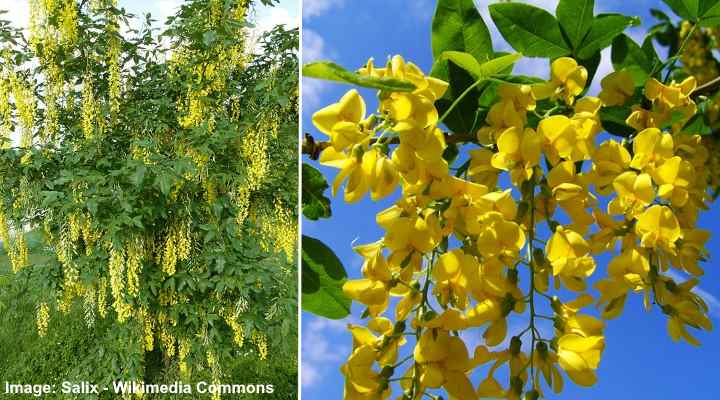
The golden chain is a captivating small spring-blooming tree with hanging clusters of small, pea-like yellow flowers. These lovely yellow flower clusters can extend up to 2 ft. (60 cm) in length. The leaves of this tree are composed of three oblong leaflets, resembling clover leaves.
Golden chain trees thrive in USDA zones 6 – 8. For optimal growth, these deciduous trees are ideally cultivated as specimen trees or trained over arbors or pergolas. Make sure to plant these trees in organically rich and well-drained soil.
Mature Size: 12 – 15 ft. (3.6 – 4.5 m)
USDA Hardiness Zones: 6 – 8
Sun: Full sun to partial shade
Pineapple Broom Tree (Cytisus battandieri)
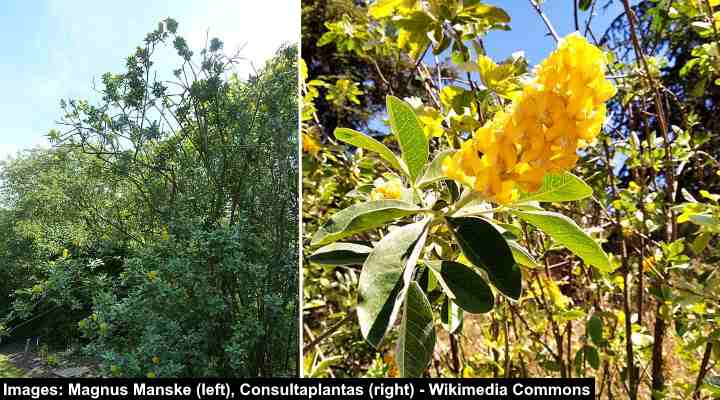
The small pineapple broom tree is recognized for its clusters of pea-like, golden-yellow flowers. These charming flowers blossom on vertical cylindrical spikes, emitting a pineapple-like fragrance, earning the tree its name. From late spring until summer, this tree blooms with vibrant green and yellow hues, resulting in a lively and colorful atmosphere in backyards.
Also known as the Moroccan broom tree, it features 3-lobed, gray-green, needle-like leaves with a unique velvety texture. The tree is drought-tolerant and can thrive in poor soil conditions. This yellow-flowering tree can become a versatile addition to your garden. Whether as an accent plant, a stunning flowering specimen tree, or a strategic choice to attract pollinators and wildlife, it holds immense value in enhancing any garden landscape.
Mature Size: Up to 13 ft. (4 m) tall and wide
USDA Hardiness Zones: 7 to 10
Sun: Full sun
Mexican Bird of Paradise (Caesalpinia mexicana)

The Mexican bird of paradise, a woody shrub or small tree, is known for its clusters of bright yellow flowers. Gracefully dangling in showy racemes, these attractive flowers measure about 6 inches (15 cm) long. As the blooming season ends, large, curled seed pods become visible. In frost-free regions, this ornamental tree maintains its evergreen foliage.
Mexican bird of paradise trees are popular for their ornamental, dark-green leaves and stunning flower clusters. This rapidly growing, shrub-like tree can become a versatile addition to your garden. Whether as an accent plant, flowering tree, or focal point, it is sure to add beauty to your landscape. Throughout the blooming season, garden enthusiasts are sure to be captivated by the vibrant display of yellow blooms this tree offers.
Mature Size: 10 to 15 ft. (3 – 4.5 m) tall and wide
USDA Hardiness Zones: 9 to 11
Sun: Full sun
Yellow Silk Cotton Tree (Cochlospermum religiosum)
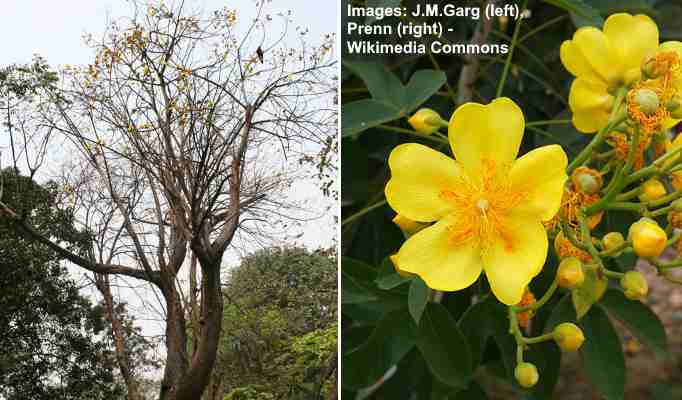
The yellow silk cotton tree is a small, tropical tree known for its stunning five-petaled yellow flowers. During the spring and summer months, this tree becomes a delightful sight with its large, buttercup-shaped blooms, forming a captivating and beautiful display. Additionally, the tree produces seeds enveloped in a fluffy, cotton-like substance.
The yellow silk cotton tree, also known as the buttercup tree, is a versatile addition to xeriscapes, excelling as both an accent plant and an ornamental tree. Its spreading canopy also makes it a good choice as a shade tree. This tree is sure to add a touch of beauty and elegance to your garden landscape.
Mature Size: Up to 25 ft. (7.5 m) tall and wide
USDA Hardiness Zones: 9 to 11
Sun: Full sun
Goldenball Leadtree (Leucaena retusa)

Goldenball Leadtree (Leucaena retusa)
The goldenball leadtree is a small, deciduous tree known for its clusters of beautiful, pom-pom-like yellow flowers. With the arrival of spring and fall, this tree covers itself with fluffy yellow blooms and showcases its bipinnate, compound leaves. In addition, it grows lengthy brown seed pods, each about 6 inches (15 cm) in length. After rainfall, the leadtree erupts in a stunning display of golden-yellow colors.
The goldenball leadtree, native to the United States and northern Mexico, is also known for its droopy, shrub-like growing habit. It is particularly ideal for gardens in southern regions. In addition, these trees exhibit tolerance to drought, heat, and salt, making them adaptable across different environmental conditions.
Mature Size: 20 to 25 ft. (6 – 7.6 m) tall and wide
USDA Hardiness Zones: 7 to 9
Sun: Full sun
Golden Wreath Wattle (Acacia saligna)
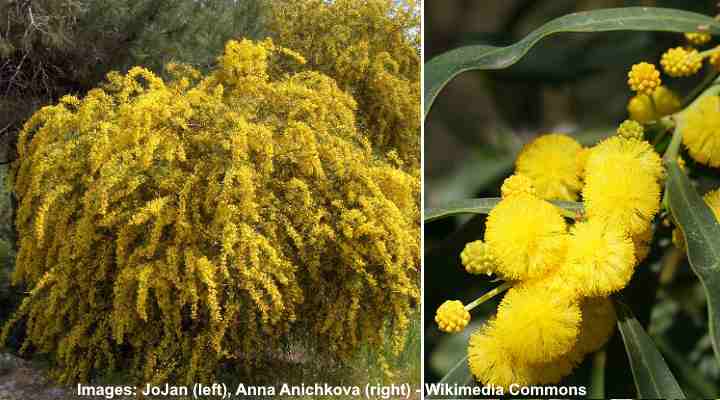
The golden wreath wattle is a multi-stemmed, fast-growing shrub or small tree known for its drooping, beautiful yellow flower clusters. Its radiant, spherical flowers bloom in spring. The tree’s long, narrow, dark green leaves, which can grow up to 10 inches (25 cm) long, beautifully contrast against the yellow blooms. The tree also produces masses of elongated, flattened seed pods with round, black seeds.
The golden wreath wattle is frequently used as a decorative tree, adding a splash of color to outdoor landscapes, such as parks and gardens. The tree is fast-growing and tolerant of high desert heat. Although it is adaptable to many soil types, it grows best in well-draining soil with a sandy or loamy texture. With its radiant flowers and attractive foliage, the golden wreath wattle is a delightful and captivating addition to any landscape.
Mature Size: 10 to 26 ft. (3 to 8 m)
USDA Hardiness Zones: 9-11
Sun: Full sun
Yellow Bell Orchid Tree (Bauhinia tomentosa)

The yellow bell orchid tree is a small, tropical tree recognized for its pale yellow, orchid-like flowers. These distinctive, bell-shaped flowers have large petals with a black to maroon center, creating a stunning display. Another identifying feature of this tree is its light green, two-lobed leaves, which resemble wings. It also produces flat, elongated brown seed pods.
The yellow bell orchid tree’s pale yellow flowers contrast beautifully against its lush, light green foliage. With its appealing features, this tree is guaranteed to enhance the beauty of any landscape.
Yellow bell orchid trees are found in the tropical and subtropical regions of Africa and south Asia. Once established, these trees are drought-tolerant. They require six to eight hours of sunlight a day for optimal growth. During the summer, these trees produce delightful nectar that serves as a magnet for butterflies and bees, making them a great addition to any outdoor area.
Mature Size: Up to 24 ft. (7 m) tall and wide
USDA Hardiness Zones: 9 to 11
Sun: Full sun
Palo Verde (Parkinsonia aculeata)
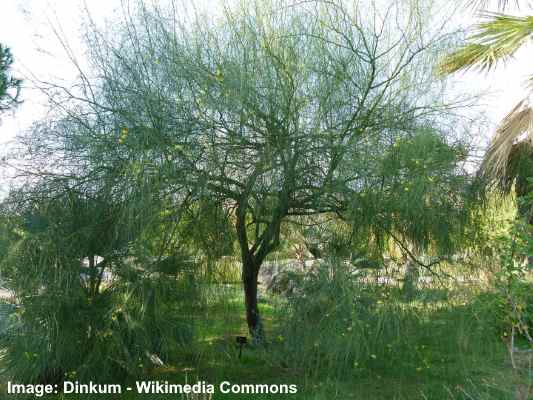
The palo verde is a small, deciduous tree known for its clusters of fragrant, orange-yellow flowers. This tree is identifiable by its unique, bright-green bark and compound, bipinnate leaves. Additionally, the tree’s branches are adorned with thorns and elongated, slender seed pods.

The palo verde, often found in California, thrives in dry and semi-dry conditions. Once established, it is tolerant of drought, salt, and heat. Make sure to plant this tree in well-draining, sandy soil. This tree can become a versatile addition to your landscape. Whether as a focal point, shade tree, or individual specimen tree, this tree is sure to add charm and beauty to your garden landscape.
Mature Size: 15 to 20 ft. (4 to 6 m)
USDA Hardiness Zones: 8-11
Sun: Full sun
Blue Palo Verde (Parkinsonia florida)
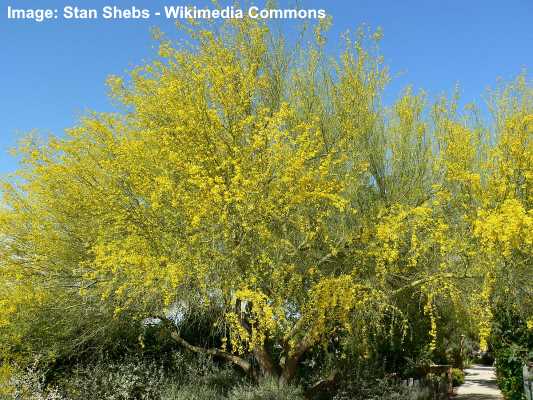
Blue palo verde (Parkinsonia florida) tree in bloom
The blue palo verde is a small tree known for its distinctive blue-green bark and beautiful, golden-yellow flowers. The flowers grow close together in dense clusters and have a papery texture with red stamens. The tree also showcases tiny, pinnately compound leaves that are blue-green in color. During spring, the tree transforms into a beautiful golden-yellow hue, adding a touch of vibrancy to arid landscapes.

The blue palo verde tree is often found in the dry, desert climates of California, Nevada, and Arizona. Being resilient to tough conditions like drought and poor soil, this tree is an excellent choice for planting in xeriscapes and desert gardens. The tree is also useful for preventing erosion in difficult soils.
Interestingly, the blue palo verde is the state tree of Arizona.
Mature Size: 20 to 25 ft. (3 – 7.5 m) tall and up to 20 ft. (6 m) wide
USDA Hardiness Zones: 8 to 11
Sun: Full sun
Palo Brea (Parkinsonia praecox)

The palo brea is a semi-evergreen small tree with stunning yellow flowers and attractive blue-green bark. The tree has twisted branches, forming a spreading, umbrella-shaped canopy. It also showcases pinnately compound, blue-green leaves. In mid- to late-spring, it brightens up the landscape with vibrant yellow blooms, creating a beautiful contrast against the green foliage.
Palo brea trees are highly suited for planting in arid conditions due to their ability to withstand drought and extreme heat. Flourishing in sunny locations, they make excellent selections for xeriscape gardens or as standout trees in desert landscapes. Their attractive green bark and vibrant yellow flowers have made them a favored choice for introducing color and visual allure to desert landscapes.
Mature Size: 20 to 25 ft. (6 – 7.6 m) tall and wide
USDA Hardiness Zones: 9 to 11
Sun: Full sun
Yellow Bells (Tecoma stans)

The yellow bells, also known as the yellow trumpet flower, is a fast-growing, evergreen shrub or small tree. This ornamental tree is known for its beautiful clusters of bright yellow, funnel-shaped flowers. From spring until the first frost, the tree showcases these stunning yellow blooms, creating a beautiful display that lasts all season.
Native to Texas, Florida, and New Mexico, the yellow bells is a tough tree that can handle hot temperatures and dry conditions. This makes the small flowering tree an excellent choice for adding a pop of color to xeriscapes and desert gardens. Additionally, this tree requires little maintenance and can be effortlessly pruned to retain its desired size and shape. It is tolerant of many soil conditions but thrives best in rich, moist, well-drained soil.
Mature Size: 10 to 25 ft. (3 – 7.5 m) tall and wide
USDA Hardiness Zones: 9 to 11
Sun: Full sun or partial shade
Lilac ‘Primrose’ (Syringa vulgaris ‘Primrose’)
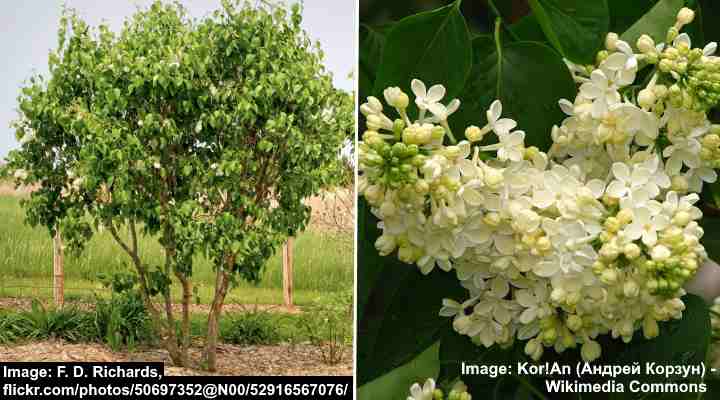
The ‘Primrose’ lilac variety is a deciduous shrub or small tree known for its beautiful panicles of small, pale yellow flowers. The tree’s beautiful flowers begin blooming in late spring, lasting for about four weeks. These flowers release a delightful scent, attracting pollinators such as butterflies and bees, making your garden even more charming.
The ‘Primrose’ lilac tree features distinctive heart-shaped green leaves that beautifully transition into a yellowish hue during the fall, providing a delightful touch of autumn colors to your garden. This small tree is low-maintenance and thrives in well-drained soil.
The yellow-flowering lilac ‘Primrose’ boasts captivating spring blooms and can serve as a flowering hedge, foundation plant, or an exquisite addition to your perennial border, elevating your landscape’s appearance.
Mature Size: 10 to 12 ft. (3 – 3.6 m) tall and wide
USDA Hardiness Zones: 4 to 7
Sun: Full sun to partial shade
Yellow Oleander (Cascabela thevetia)

The yellow oleander is a large, spreading shrub or small tree recognized for its beautiful, yellow funnel-shaped flowers. In warmer climates, it flourishes and enhances the landscape throughout summer and fall with its vibrant yellow flowers. This evergreen tree has willow-like, glossy leaves and dark red-black seed pods, enhancing its overall appeal.
While the yellow oleander is attractive due to its decorative features, it is important to be aware that all parts of this tree are toxic if ingested. Make sure to be careful when planting the tree in areas often visited by children or pets. Despite its toxic nature, this decorative tree remains a favored option for parks and gardens due to its small size and low-maintenance characteristics.
Mature Size: Up to 8 ft. (2.4 m) tall and 4 ft. (1.2 m) wide
USDA Hardiness Zones: 8 to 10
Sun: Full sun to partial shade
Yellow Flowering Camellia Tree (Camellia)
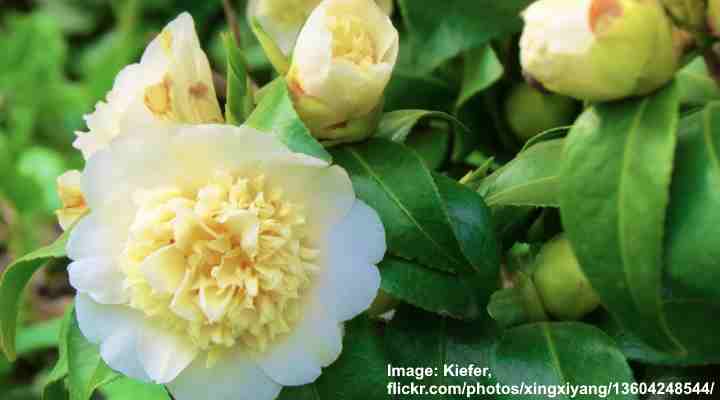
Yellow-flowering camellia trees are renowned for their striking yellow blossoms. The flowers beautifully contrast against their glossy, dark green foliage. These trees are renowned for their sizeable and impressive flowers, with certain varieties displaying exquisite double blooms. Blooming in early spring, they add a touch of beauty to the spring landscape.
Yellow camellia trees thrive best in acidic and well-drained soil. They achieve optimal growth in areas with partial shade to full sun. This versatile tree can be used as either a privacy hedge or an individual focal point. Camellia trees, covered with their breathtaking flowers and glossy evergreen leaves, are sure to add a touch of elegance to any outdoor landscape.
Mature Size: 10 to 13 ft. (3 – 4 m) tall and 5 to 10 ft. (1.5 – 3 m) wide
USDA Hardiness Zones: 7 to 10
Sun: Partial shade
Weeping Scotch Laburnum (Laburnum alpinum ‘Pendulum’)
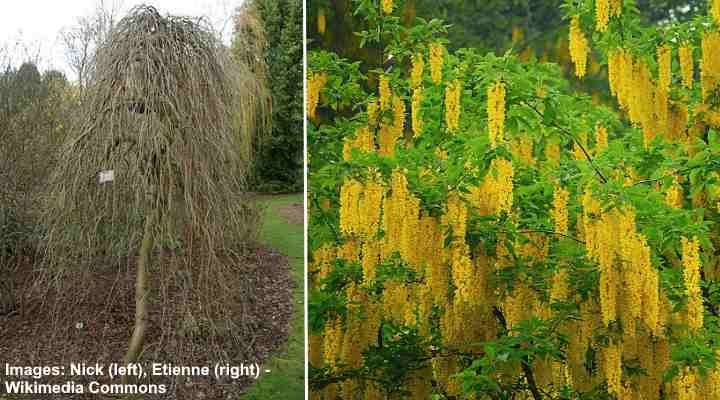
The weeping Scotch laburnum is an attractive, dwarf tree known for its long flower clusters that hang gracefully. This tree, with its small, sweet-smelling flowers and lush green foliage, makes a fantastic choice as an ornamental tree in any garden landscape.
The weeping Scotch laburnum is adaptable to many soil types, though for optimal growth plant it in moist, well-drained soil. With its gracefully weeping branches and compact size, it’s great for planting in small gardens or compact spaces. Use this tree as an individual focal point or to amplify the curb’s overall appeal in your front yard.
Mature Size: 6.5 to 8 ft. (2 – 2.5 m) tall and up to 6.5 ft. (2 m) wide
USDA Hardiness Zones: 5 to 7
Sun: Full sun or partial shade
Cornelian Cherry (Cornus mas)
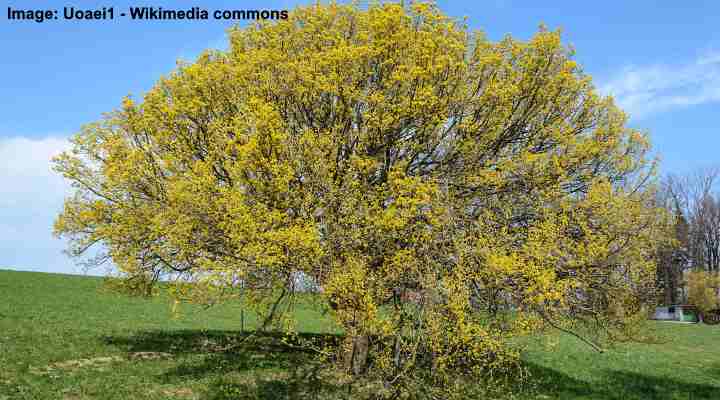
Cornelian Cherry Dogwood (Cornus mas)
The Cornelian cherry is a lovely deciduous shrub or small tree, recognized for its decorative features and bright yellow blooms. During early spring, the tree’s umbrella-shaped canopy is covered with a stunning display of golden-yellow blooms before the green, oval-shaped leaves emerge.
As the season progresses, the tree’s leaves transform into a rich green hue, while in midsummer, it showcases striking red berries.
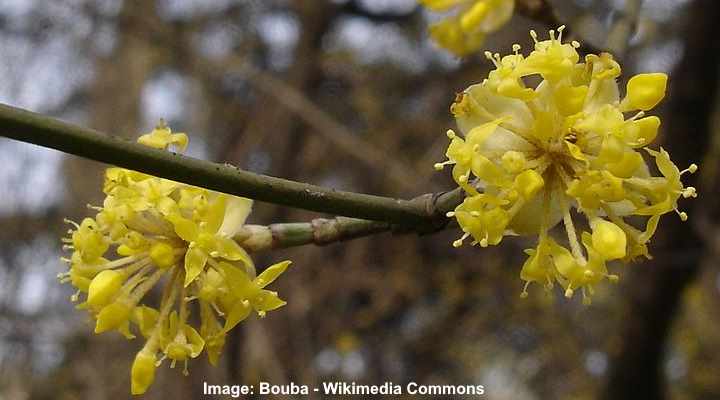
Cornus mas flowers
The Cornelian cherry tree is adaptable to a variety of different soil types, though it grows best in moist soil. Their versatility makes them suitable for various purposes, such as ornamental trees, hedges, privacy screens, or specimen plants, adding beauty to landscapes. With its attractive yellow flowers and sweet red fruits, this tree is a popular choice for enhancing the beauty of gardens.
Mature Size: 15 to 25 ft. (4.5 – 7.6 m) tall and 21 to 20 ft. (3.6 – 6 m) wide
USDA Hardiness Zones: 5 to 8
Sun: Full sun to partial shade
Golden Wonder Tree (Senna spectabilis)
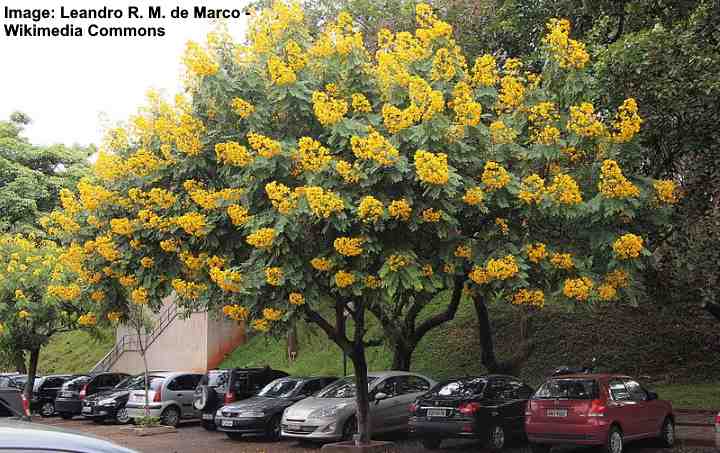
Senna spectabilis
The golden wonder tree is a stunning ornamental tree known for its abundant conical clusters of small, yellow flowers. These summer-blooming flowers stand out beautifully against the tree’s lush, evergreen foliage. The tree’s fern-like leaves combine to form compound leaves, which can grow to a size of up to 3 inches (7.5 cm).
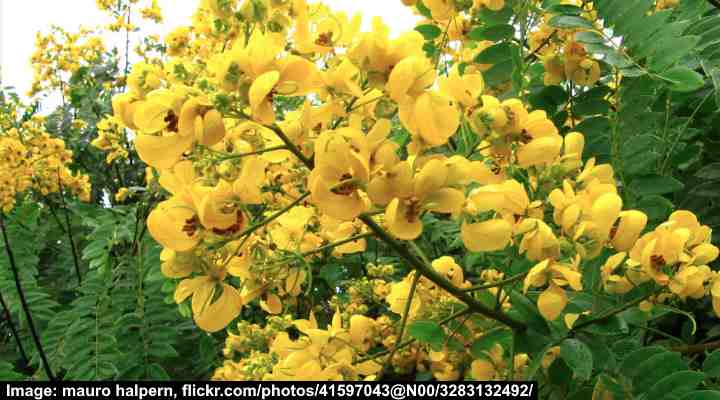
Senna spectabilis flowers
The small golden wonder tree, adorned with captivating golden yellow flowers, is an excellent selection for enhancing the ornamental appeal of your garden. Its wide, spreading canopy also makes it a good choice as a shade provider. This fast-growing tree is drought- and heat-tolerant. It also adapts to many different soil types.
The golden wonder tree, an ideal choice for tropical gardens, is sure to bring a burst of color to your landscape.
Mature Size: 15 to 20 ft. (4.5 – 6 m) tall and wide
USDA Hardiness Zones: 9 to 11
Sun: Full sun
Candelabra Tree (Senna didymobotrya)
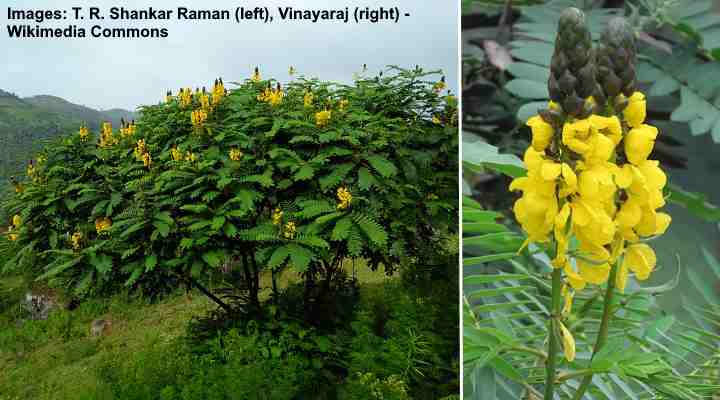
The candelabra tree is a delightful small, ornamental tree admired for its vibrant and stunning yellow blossoms. The tree is also commonly referred to as the popcorn tree or peanut butter cassia. Some of the best features of this tree are its cone-like, yellow flower clusters, large oval-shaped leaves, and elongated seed pods. In addition, this tree has a distinctive flower scent reminiscent of peanut butter, burnt popcorn, or even a damp dog.
The yellow-flowering candelabra tree thrives in warm, humid climates and prefers rich, moist, well-draining soil. This tree is an excellent choice for adding some appeal to your landscape, whether as an ornamental tree, focal point, or accent piece. The vibrant yellow flower clusters are sure to elevate the beauty of your garden while also attracting essential pollinators like butterflies and bees.
Mature Size: Up to 16 ft. (5 m) tall
USDA Hardiness Zones: 9 to 11
Sun: Full sun
Sweet Acacia (Vachellia farnesiana)

Texas Huisache (Sweet Acacia) (Vachellia farnesiana)
The sweet acacia is a semi-evergreen shrub or small tree known for its dazzling clusters of yellow-orange, pom-pom-like flowers. During the late winter and spring seasons, these highly aromatic and charming blossoms capture the attention of bees, butterflies, and other pollinators. Its feathery, fern-like leaves further elevate its ornamental appeal.
Sweet acacia trees grow best in well-drained soil. Once established, these plants are tolerant to salt spray, salty wind, and drought, making them ideally suited for coastal gardens and foundation plantings. In addition, their thorny branches make them an excellent choice as a natural security screen.
Mature Size: 15 to 20 ft. (4.5 – 6 m) tall and wide
USDA Hardiness Zones: 9 to 11
Sun: Full sun to partial shade
Related articles:
